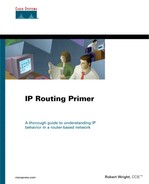Chapter 4. Using IP Unnumbered and VLSM
This chapter is broken into two sections. The first section discusses IP unnumbered. It provides scenarios showing how it works when properly configured and how it breaks when improperly configured.
The second section discusses variable length subnet masking (VLSM). It provides scenarios showing how it works when properly configured and how it breaks when improperly configured.
Before proceeding any further in this chapter, it is important to lay the groundwork for the discussion by defining the following terms:
IP unnumbered refers to using the network or subnet address of a local LAN interface as the router's network or subnetwork address for a point-to-point serial link. The term point-to-point means that only two devices are on the link, as is the case on a T1 connection between two routers or a point-to-point subinterface to a Frame Relay network. Normally, a serial link has its own unique network or subnetwork address. IP unnumbered allows a network administrator to conserve network or subnetwork addresses. IP unnumbered is especially valuable for networks running IP routing protocols such as RIP V1 and IGRP, which do not support VLSM. Without VLSM support, a network must use the same subnet mask on its serial (WAN) interfaces as it does on its LAN interfaces. For a company using an 24-bit (255.255.255.0) mask on a Class B address, this means applying a subnet capable of supporting 253 hosts on a WAN link that never has more than two hosts. See Chapter 8, "Hexadecimal and Binary Numbering and IP Addressing," for more information on IP subnetting.
VLSM means applying different subnet masks to the same major net. With VLSM, a Class B address can be subnetted with a 253–host, 24-bit mask (255.255.255.0) for the LAN subnets and a two–host, 30-bit mask (255.255.255.252) for the WAN subnets.
Host routes are routes whose associated subnet mask is set to all 1s (255.255.255.255). Remember that the subnet mask is used to separate the bits that are part of the network address from the bits that are part of the host address. In this case, the mask covers all of the bits, leaving no bits for the host portion. Because a subnet that is all network with no hosts would be of little use, it was decided that this subnet mask would be used as a host route pointing to a particular host. The section covering host routes in dial-on-demand routing (DDR) network configurations helps clarify this point.
DDR is providing temporary connections between networks or between users who are not based at the same site. DDR is often used when a permanent connection is not cost-efficient because data is only exchanged sporadically. Automated teller machines (ATMs) use DDR to contact their central host when verifying a transaction. This is typically done using a dial-up connection, such as a telephone line or an Integrated Services Digital Network (ISDN) connection.
